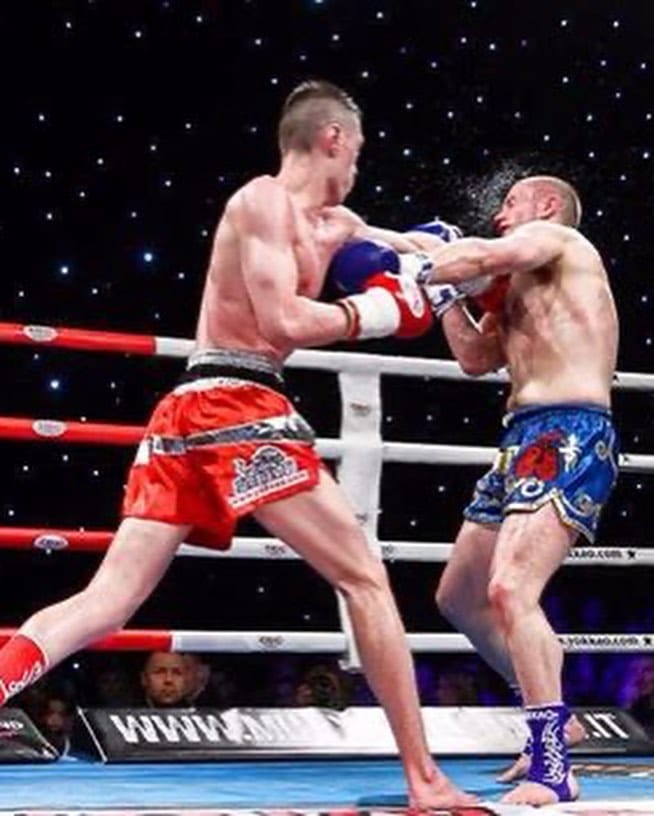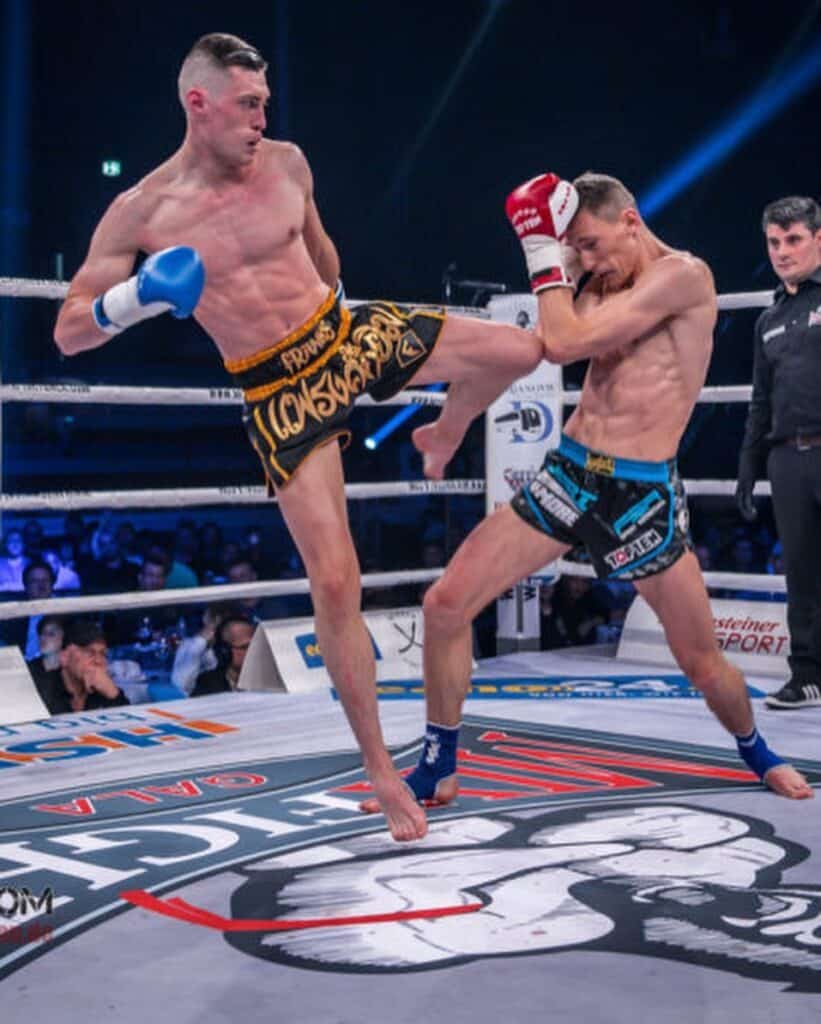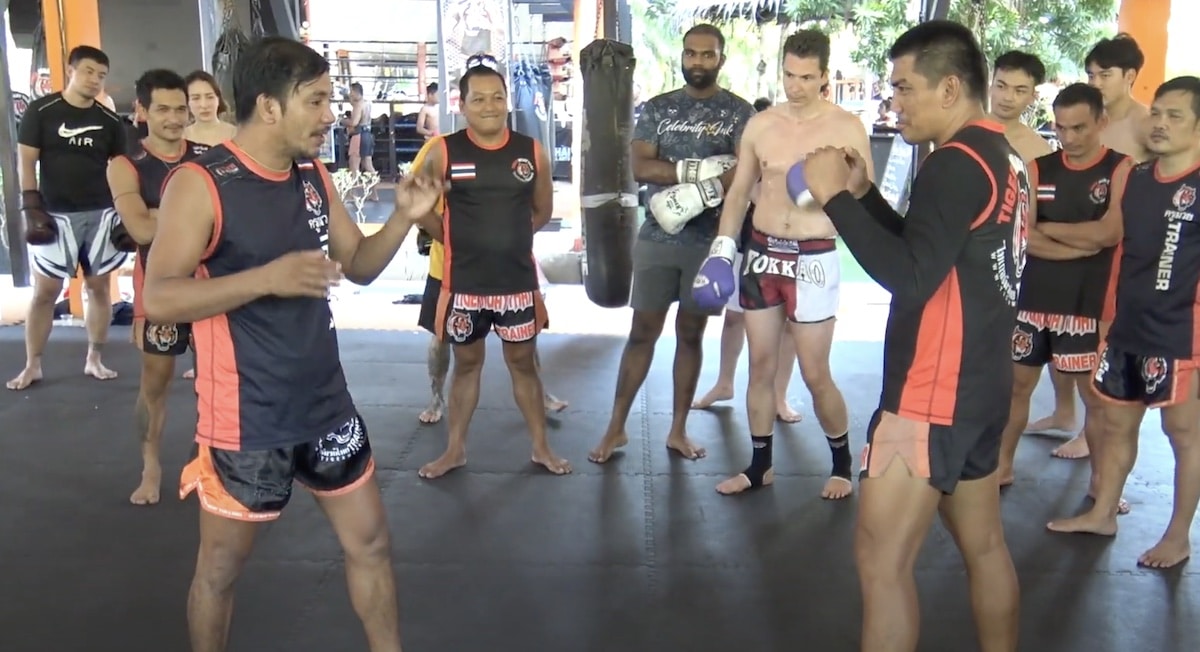Muay Thai Techniques
Muay Thai is an incredibly effective striking martial art with a wide variety of different techniques. Making it one of the most complex striking martial arts.
That is why we need to do a full breakdown of Muay Thai techniques. Going through all of the different Muay Thai techniques, which includes all of the strikes.

How many Muay Thai techniques are there?
Punches
Punching is primarily associated with boxing, but it’s also one of the primary Muay Thai techniques. Thai boxing teaches many of the same punching techniques as traditional boxing with a few extra types of punches. Here is a list of all of the punches that are used within Muay Thai.
Jab (Mat Nueng)
The jab is the set up punch for nearly all Muay Thai techniques, just like it is in boxing. It’s a snapping strike that not only sets up your Muay Thai combos, but also measures the distance to your opponent.
Hook (Mat Wiang San)
The hook punch is also used in both boxing and Muay Thai, where it is known as the “Mat Wiang San.” A powerful punch that hooks across the body and can be used with both your front and back hand.
Cross/Straight (Mat Trong)
A cross or straight punch is known as the “Mat Trong in Muay Thai. Just like in boxing, the cross is one of the strongest punches that is thrown with your back hand.
Uppercut (Mat Soi Dao)
The uppercut is known in Muay Thai as “Mat Soi Dao.” A powerful punch that comes from below and cuts upward towards your opponent. How it is taught in Muay Thai is very similar to how it’s taught in traditional boxing.
Overhand (Mat Wiang Yao)
In Muay Thai, the overhand or haymaker punch is also taught and is called the “Mat Wiang Yao.” The punch thrown with your backhand that loops up instead of straight like how a cross is thrown.
Spinning Backfist (Mat Wiang Klap)
The spinning backfist is one of the most popular and powerful punches that is used in Muay Thai and also MMA. In Thai, the spinning backfist is known as the “Mat Wiang Klap.”
Superman Punch (Kradot Chok)
Then the last type of punch that’s taught in Muay Thai is the superman punch or “Kradot Chok.” The punch that we often see in MMA, where you leap at your opponent like Superman to land a punch.
Elbows
We went over Muay Thai elbows in a previous write up, where we broke down how to throw each type. They’re Muay Thai techniques that are a vital part of the martial art.
Horizontal Elbow (Sok Tad)
The horizontal elbow is the standard elbow strike within these Muay Thai techniques that’s called “Sok Tad” in Thai. It can either be thrown as a slashing or smashing strike, depending on what your objective is.
Spear Elbow (Sok Poong)
The spear elbow is like the jab of the elbow strikes in Muay Thai. To throw it, you step forwards and throw your front elbow and jab it forward like a spear.
Downward Smash/Tomahawk Elbow (Sok Tong)
A downward smashing or tomahawk elbow is a devastating elbow used with your back arm. Designed to smash a hard elbow strike down on top of your opponent’s head.
Uppercut Elbow (Sok Ngad)
An uppercut elbow or “Sok Ngad” as it’s called in Thai is thrown almost exactly how you throw an uppercut punch. The big difference however is that you hit your opponent with the intent to cut or KO them.
Spinning Elbow (Sok Klab)
The spinning elbow in MMA was adopted from Muay Thai, where its Thai name is “Sok Klab.” The spinning elbow is commonly thrown off missed roundhouses, hooks, or overhand punches.
Diagonal Elbow (Sok Chiang)
The diagonal elbow is an elbow thrown upward at a 45 degree angle towards your opponent’s face. A diagonal elbow’s main purpose is to cut your opponent, which comes from an awkward angle that’s hard to read.
Upward Elbow (Sok Kratung)
A Sok Kratung or upward elbow is the strike that Anderson Silva made famous. It’s masked as an horizontal elbow, then chambered and thrown outward and upward toward your opponent.
Muay Thai kicks

Kicks are one of the Muay Thai techniques that the martial art is most known for. There is a wide variety of Muay Thai kicks and many of them are quite deadly.
Roundhouse/Round Kicks (Tae Tat)
Roundhouses or round kicks are one of the Muay Thai techniques that most people are aware of. They are incredibly powerful kicks, where you drive the bottom of your shin into your opponent’s body.
Front Kicks (Teeps)
Front kicks or teeps are some of the most versatile Muay Thai techniques in the martial art. They have numerous purposes from using them as a jab, push to make space, or deliver a knockout blow.
Sidekicks (Tae Tad)
Sidekicks are taught in Muay Thai, but they are vastly different from what you see in Karate or Taekwondo. A Muay Thai sidekick is thrown straight from the floor and isn’t chambered like in the other martial arts mentioned.
Jumping Push Kick (Kradot Teep)
Another type of teep kick that is one of the strongest is the jumping push kick or “Kradot Teep.” This type of teep is where you jump straight at your opponent and hit them with a front kick or push kick.
Question Mark Kick (Tae Chiang)
A question mark kick is a variation of a roundhouse kick that is disguised as a front kick. You bring your foot up like a front kick, but redirect your kick into a roundhouse. The movement your foot makes looks exactly like a question mark, which is how it got the name.
Axe Kick (Tae Khao)
The axe kick is an incredibly powerful kick that is commonly used within Muay Thai. Throwing your foot straight up into the air and driving your heel down onto your opponent.
Wheel Kick (Tae Klap Lang)
The wheel kick is another type of kick that is thrown in most striking martial arts like Muay Thai. You create force off a spin to hit your opponent with your heel.
Muay Thai clinches
Clinches are Muay Thai techniques are the grappling facet of Muay Thai that take years to properly learn. There are a wide variety of different types of clinches that each have their own purpose.
Standard Thai Plum/Clinch
The standard Thai plum, collar ties, or clinch is where you’re controlling your opponent’s head with both arms. Grabbing the back of their head with both hands and breaking their posture down to land knees, punches, and elbows.
Single Collar Tie
A single collar tie is where you’re holding and your opponent’s head with just one arm. Your other arm is blocking your opponent’s other arm from either defending or striking. Almost the same as what’s used in wrestling, but with strikes involved.
Over/Under
The over/under is the common starting position in Muay Thai, where fighters battle for position. Either trying to set up their elbows, knees, and also sweeps from this position.
Double Unders
Double unders are another type of clinch that is used in both wrestling and Muay Thai. You’re controlling your opponent’s body with both of your arms under their arms. Using this position to land body shots and set up sweeps.
Muay Thai throws/sweeps
Throws and sweeps are one of the most important Muay Thai techniques that new Thai boxing fans know about. Thai boxers will routinely throw their opponents to the ground with the clinch or off defending kicks. There are quite a few different types of throws and sweeps, but here are some of the most common ones.
Clinch Sweep
The most basic Muay Thai sweep is the clinch sweep, which is used when your opponent tries to clinch. When they come forward, you grab their tricep, cup their armpit.
Using the tricep grip to pull and the armpit grip to push your opponent to complete the sweep. While doing these motions with your arms, put your knee on the side of their knee to knock them off balance.
Head/Bicep Control Sweep
A sweep from head and bicep control consists of pushing the arm and pulling the head. As you do both of these movements simultaneously, you knee the inside of your opponent’s knee to knock them off-balance.
Foot Sweep
A common foot sweep can be done from head and bicep control or double bicep control. Pull your opponent forward as you connect your shin and foot to knock them off-balance.
The Dump
The dump is where you take your opponent down as you go into the over/under position. Pushing with your underhook, pulling with your overhook, and blocking their knee with yours as your momentum goes forward.
Over/Under Sweep
Another push and pull sweep, but this type from the over/under position. Pull your opponent’s lat down as your other arm cups their armpit to take them down.
Full Clinch Sweep
From a full clinch, you Gable grip your hands together and put your head under their chin. You’re going to use that clinch to pull your opponent as you turn out to finish the sweep.
Catch & Sweep
Then of course, you have the easy sweep that comes off catching your opponent’s kick. After you catch the kick, you step in and kick your opponent’s base leg out from under them.
Knee Tap
Another sweep from the over/under position is the knee tap sweep. You push up with your underhook arm as your other hand pushes your opponent’s outside knee inward.
Muay Thai Defenses
Probably the most important Muay Thai techniques are the defenses. It’s easy to know how to throw strikes, but you must know how to defend against them.
Parrys
Parrys are used in Muay Thai, just like boxing to block straight punches, but also some elbows. Both of your hands are up and ready to block strikes and redirect them.
Blocks
Blocks are where you hug your head or body to block, punches, elbows, and kicks. Holding them tight to absorb the impact of your opponent’s strikes.
Checks
Checks are the defense to block an opponent’s roundhouse kicks to your legs. You do a check by turning your knee slightly to catch your opponent’s shin on your shin or knee.
Catches
Then, of course, you can defend certain kicks from your opponent by catching them. Usually, the types of kicks that you can catch are roundhouse kicks to the body or front kicks.


